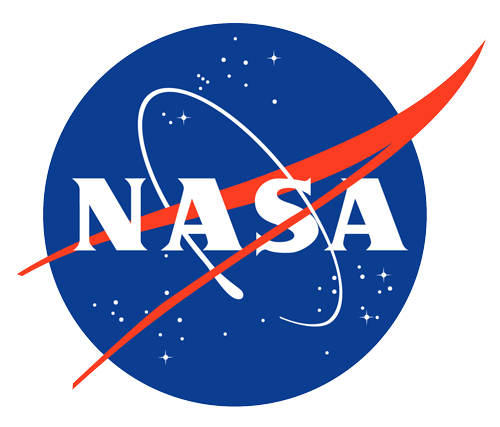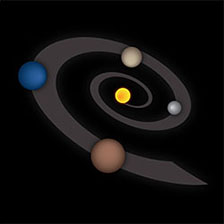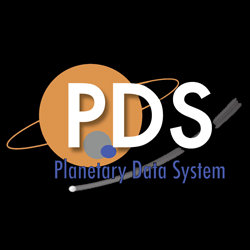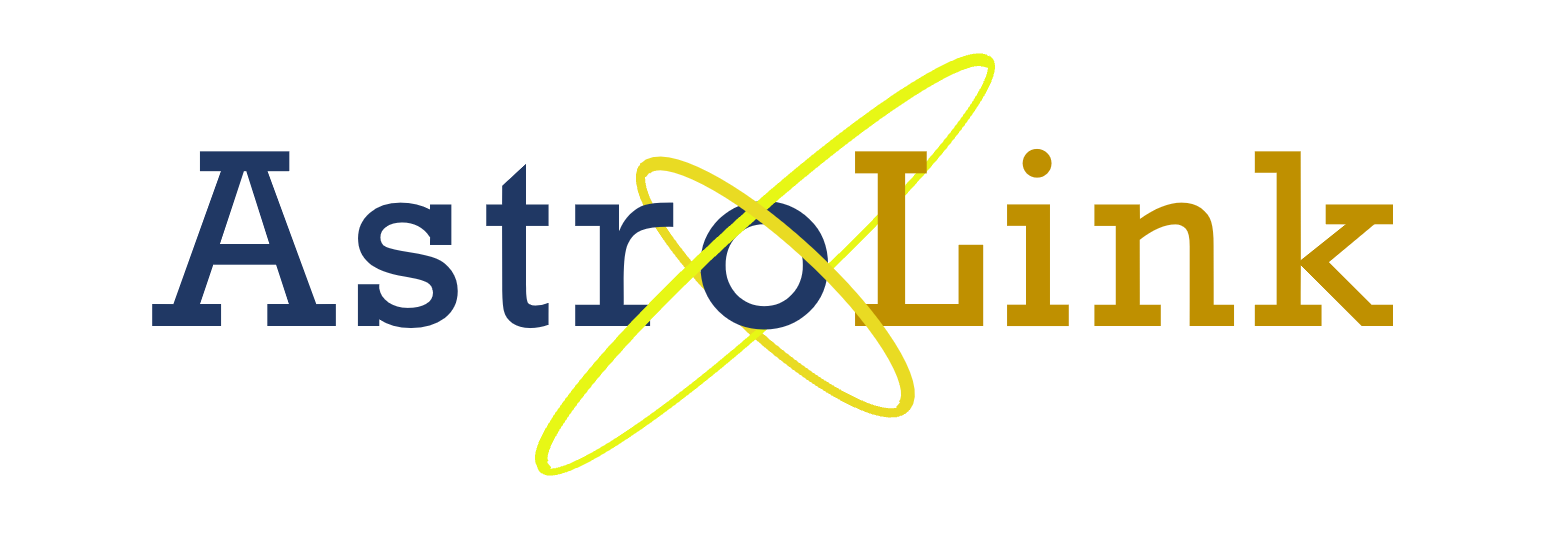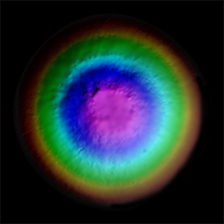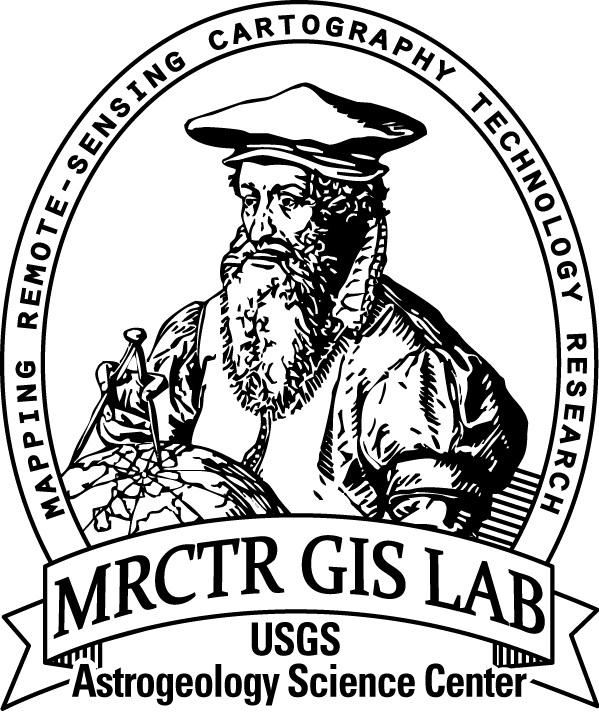Moon SELENE Kaguya MI Derived Submicroscopic Metallic Iron Mosaic 59m
- Originators
- Lemelin et al., University of Hawaii, JAXA - SELENE MI Instrument Team (M. Ohtake, PI)
- Publisher
- USGS Astrogeology Science Center
- Publication Date
- 2016-09-01
- Abstract
- Product Information: This mosaic represents SELenological and Engineering Explorer (SELENE) Kaguya Multiband Imager (MI) derived submicroscopic metallic iron (SMFe; Taylor et al., 2010). The mosaic was created from topographically-corrected MI reflectance data acquired by the JAXA SELENE/Kaguya mission (Ohtake et al., 2013) from the Kaguya Archive MI MAP processing level version 2 (MI MAP_02) products. The mosaic presented here has been resampled to 512 ppd (59 meters per pixel [m]) from its original resolution of 2048 ppd (15 m). Retrieve the graphical 8bit-stretched full-res GeoTiff and legend from the Ancillary Products section at the right-side of this page. Retrieve the graphical 8bit-stretched full-res GeoTiff and legend from the Ancillary Products section at the right-side of this page. Mission and Instrument Information: The Japan Aerospace Exploration Agency (JAXA) launched the SELenological and Engineering Explorer (SELENE) Kaguya spacecraft to the Moon in September 2007. The mission concluded June 10, 2009 when the spacecraft was intentionally crashed onto the lunar surface. Subsequent data collection and mapping efforts resulted in âthe largest lunar exploration project since the Apollo programâ (Haruyama et al., 2008). The high-performance optical TC, a 10-meter spatial resolution stereo-camera, was part of the Lunar Imager/Spectrometer (LISM) instrument suite (Kato et al., 2006), along with the Multi-band Imager (MI, 20 m; (Ohtake et al., 2008) and Spectral Profiler (SP; Matsunaga et al., 2008). The MI collects images of the lunar surface at 5 wavelengths in the ultraviolet-visible (UVVIS; 415, 750, 900, 950, 1001 nm) region of the electromagnetic spectrum and at 4 wavelengths in the near-infrared region (NIR; 1000, 1050, 1100, 1250 nm). These multispectral images have been used to derive 9 new near-global maps of the four common lunar minerals, FeO, optical maturity (OMAT), the abundance of SMFe, the grain size for plagioclase, and an estimation of the modeling error using Hapkeâs radiative transfer equations (Lemelin et al., 2015, 2016, 2019). These products only cover the latitudinal range +/-50 degrees due to the difficulty of applying adequate corrections for topographic shading at higher latitudes. Preparation details and information on limitations of these products will be presented in a future publication. For use, refer to the JAXA Conditions for material usage page ( http://jda.jaxa.jp/en/service.php ) and please credit JAXA and the SELENE/Kaguya data. ©JAXA/SELENE References: Haruyama, J., Matsunaga, T., Ohtake, M., Morota, T., Honda, C., Yokota, Y., Torii, M., Ogawa, Y., & LISM Working Group (2008). Global lunar-surface mapping experiment using the Lunar Imager/Spectrometer on SELENE. Earth Planets Space, 60, 243-255. https://doi.org/10.1186/BF03352788 Kato, M., Takizawa, Y., Sasaki, S., & SELENE Project Team (2006). SELENE, The Japanese lunar orbiting satellites mission: Present status and science goals. Paper presented at the 37th Lunar and Planetary Science Conference, Lunar and Planetary Institute, Houston, TX. https://www.lpi.usra.edu/meetings/lpsc2006/pdf/1233.pdf Lemelin, M., Lucey, P. G., Song, E., & Taylor, G. J. (2015). Lunar central peak mineralogy and iron content using the Kaguya Multiband Imager: Reassessment of the compositional structure of the lunar crust. Journal of Geophysical Research: Planets, 120, 869â887. https://doi.org/10.1002/2014JE004778 Lemelin, M., Lucey, P. G., Gaddis, L. R., Hare, T., & Ohtake, M. (2016). Global map products from the Kaguya Multiband Imager at 512 ppd: Minerals, FeO and OMAT. Paper presented at the 47th Lunar and Planetary Science Conference, Lunar and Planetary Institute, Houston, TX. http://www.hou.usra.edu/meetings/lpsc2016/pdf/2994.pdf Lemelin, M., Lucey, P. G., MiljkoviÄ, K., Gaddis, L. R., Hare, T., & Ohtake, M. (2019). The compositions of the lunar crust and upper mantle: Spectral analysis of the inner rings of lunar impact basins. Planetary and Space Science, 65, 230-243. https://doi.org/10.1016/j.pss.2018.10.003 Matsunaga, T., Ohtake, M., Haruyama, J., Ogawa, Y., Nakamura, R., Yokota, Y., Morota, T., et al. (2008). Discoveries on the lithology of lunar crater central peaks by SELENE Spectral Profiler. Geophysical Research Letters, 35(23). https://doi.org/10.1029/2008GL035868 Ohtake, M., Haruyama, J., Matsunaga, T., Yokota, Y., Morota, T., Honda, C., & LISM Team (2008). Performance and scientific objectives of the SELENE (KAGUYA) Multiband Imager. Earth Planets Space, 60, 257-264. https://doi.org/10.1186/BF03352789 Ohtake, M., Pieters, C. M., Isaacson, P., Besse, S., Yokota, Y., Matsunaga, T., Boardman, J., et al. (2013). One Moon, Many Measurements 3: Spectral reflectance. Icarus, 226(1), 364â374. https://doi.org/10.1016/j.icarus.2013.05.010 Taylor, L. A., Pieters, C., Patchen, A., Taylor, D-H. S., Morris, R. V., Keller, L. P., & McKay, D. S. (2010). Mineralogical and chemical characterization of lunar highland soils: Insights into the space weathering of soils on airless bodies. Journal of Geophysical Research, 115(2). https://doi.org/10.1029/2009JE003427
- Purpose
- The SELENE/Kaguya mission addressed the origin and evolution of the Moon by obtaining global element and mineral compositions, topological structure, gravity field and electromagnetic and particle environment of the Moon. The MI was a high-resolution multiband imaging camera with a spatial resolution in visible bands of 20 mpp and a spatial resolution in near-infrared bands of 62 mpp from the 100 km SELENE/Kaguya orbit altitude. These data support the derivation of many new products, including mineral and elemental abundance maps such as those presented here.
Contact and Distribution
- Format
- Grey Scale, Mineral Map, Raster Data, Remote-sensing Data
- Access Constraints
- None
- Access Scope
- PDS
- Use Constraints
- Please cite JAXA usage terms
- Series Id
- MI MAP
- Edition
- version 1, 512 ppd
- Supplemental Information
- http://jda.jaxa.jp/en/service.php, https://link.springer.com/article/10.1186%2FBF03352789, https://www.sciencedirect.com/science/article/pii/S0019103513002108, https://www.hou.usra.edu/meetings/lpsc2016/pdf/2994.pdf, https://pds-imaging.jpl.nasa.gov/documentation/PDS_KaguyaData_Jan.31.11.pdf, https://pds-imaging.jpl.nasa.gov/portal/kaguya_mission.html, https://pds-imaging.jpl.nasa.gov/documentation/LISM-SPICE_Format_en_V01.3.pdf
- Native Data Set Environment
- GDAL, ISIS v3
- Astrogeology Theme
- Image Processing, Mineral resources, Remote Sensing, Selenography
- Mission Names
- Kaguya
- Instrument Names
- MI
- Online Package Link
- https://astrogeology.usgs.gov/search/map/moon_selene_kaguya_mi_derived_submicroscopic_metallic_iron_mosaic_59m
- External File Size
- 35 GB
- Online File Link
- https://planetarymaps.usgs.gov/mosaic/Lunar_MI_mineral_maps/Lunar_Kaguya_MIMap_MineralDeconv_AbundanceSMFe_50N50S.tif
- Contact Address
- 2255 N. Gemini Drive
- Contact City
- Flagstaff
- Contact State
- AZ
- Contact Postal Code
- 86001
- Contact Email
- astroweb@usgs.gov
Data Status and Quality
- Time Period of Content (start)
- 2007-10-19
- Time Period of Content (stop)
- 2008-10-31
- Currentness Reference
- Ground condition
- Progress
- In Work
- Update Frequency
- As needed
- Logical Consistency
- The MI reflectance data were provided by the SELENE team; information about the MAP processing level reflectance can be found in KAGUYA (SELENE) Product Format Description â Lunar Imager/Spectrometer (LISM (TC/MI/SP)) / SPICE Kernel, version 1.3 (2010). See Source Online Linkage below. The MI ultraviolet-visible (UVVIS) data (5 spectral bands, at 415, 750, 900, 950, 1001 nm) were used to derive 9 new near-global maps of common lunar minerals, FeO, TiO2, and optical maturity (OMAT) using Hapkeâs radiative transfer equations (Lemelin et al., 2016).
- Completeness Report
- The MAP level reflectance data product has been derived from 50N to 50S latitude of the Moon. There are data gaps within the mosaic set to NoData.
- Process Description
- KAGUYA (SELENE) Product Format Description â Lunar Imager/Spectrometer (LISM (TC/MI/SP)) / SPICE Kernel, version 1.3 (2010). See Source Online Linkage below. Original product at 2048ppd (15 m/p) data was sub-sampled to 512ppd (59 m/p).
Lineage
- Process Date
- 2015-08-01
- Source Title
- KAGUYA (SELENE) Product Format Description â Lunar Imager/Spectrometer (LISM (TC/MI/SP)), SPICE Kernel, version 1.3 (2010)
- Source Online Linkage
- {http://darts.isas.jaxa.jp/planet/pdap/selene/index.html.en,http://www.kaguya.jaxa.jp/index_e.htm}
- PDS Status
- PDS 3 Like
- Attribute Accuracy Report
- Best Effort
- Horizontal Positional Accuracy Report
- Best Effort
Geospatial Information
- Target
- Moon
- System
- Earth
- Minimum Latitude
- -50
- Maximum Latitude
- 50
- Minimum Longitude
- -180
- Maximum Longitude
- 180
- Direct Spatial Reference Method
- Raster
- Object Type
- Grid Cell
- Raster Row Count (lines)
- 184320
- Raster Column Count (samples)
- 51200
- Bit Type (8, 16, 32)
- 32
- Quad Name
- LQ-2, LQ-7, LQ-24, LQ-29
- Radius A
- 1737400
- Radius C
- 1737400
- Control Net
- Kaguya
- Bands
- 1
- Pixel Resolution (meters/pixel)
- 59.2252938
- Scale (pixels/degree)
- 512
- Map Projection Name
- Simple Cylindrical
- Latitude Type
- Planetocentric
- Longitude Direction
- Positive East
- Longitude Domain
- -180 to 180

